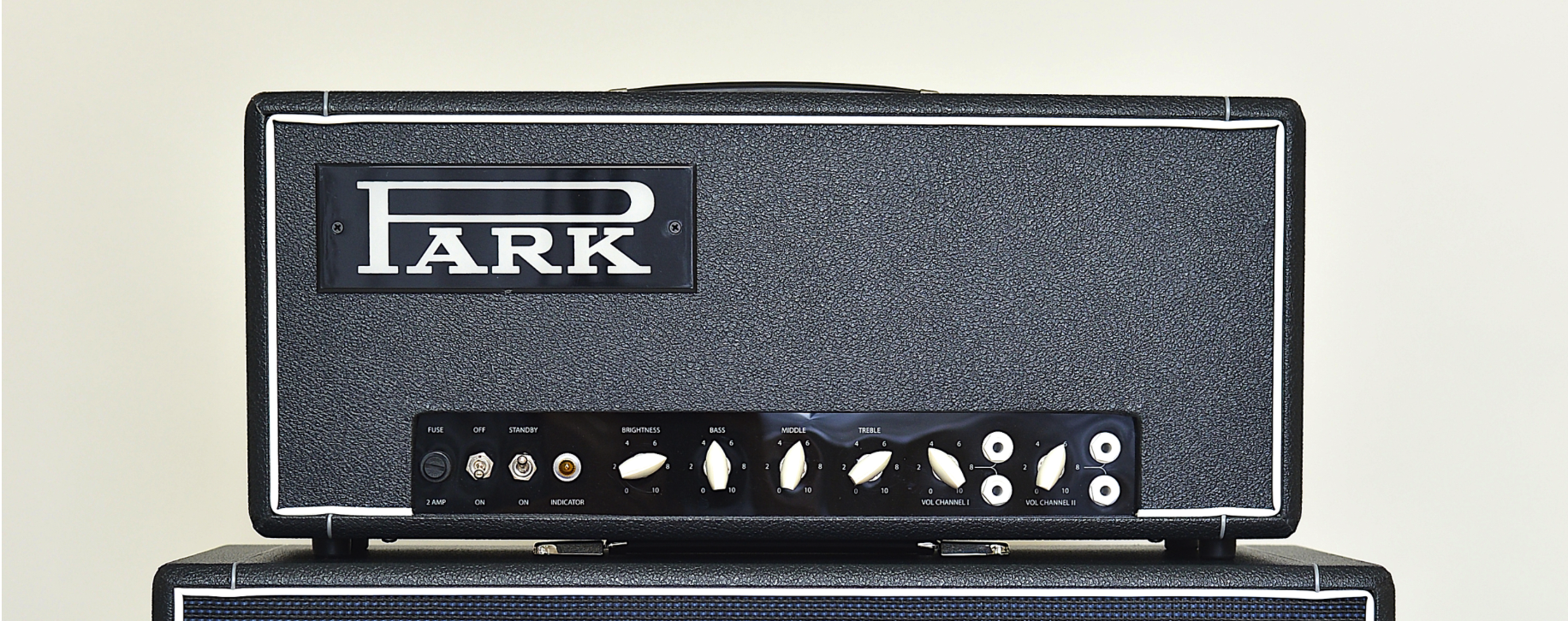Many Marshall fans are hip to the parallel history of Park Amplification—Jim Marshall’s other amp line, created to maximize sales without violating Marshall’s distribution contracts. Despite their distinct look, Park amps of the ’60s and early ’70s were similar to the era’s Marshalls, and are exceedingly collectible.
Now, many years after Park’s demise, the brand name returns via a high-end line of hand-wired, U.S.-made amps under the leadership of longtime Marshall and Vox veteran Mitch Colby. We checked out the new Park P45, a 2-channel, 4-input, 45-watt head powered by a pair of KT66 power tubes, JTM45-style. (Park also offers a combo version with a pair of 12" Celestion Heritage G12Ms.)
Park vs. Marshall I was hazy on the exact circuit variations between ’60s Marshalls and Parks, so I queried an expert on vintage British amps: Colby himself. As he explained via email: “In general, Park amps were closer to the bass or PA versions of the equivalent Marshall amps. You rarely find Park amps with bright caps on the volume control (no cap equals the bass version). Sometimes there’s not even a cap across the ‘bright’ channel mix resistor, as in the PA version. Without both caps, the channels sound exactly the same, as in the PA version. So Parks are typically warmer-sounding than the equivalent Marshalls.”
Like a ’60s Marshall bass model, the new Park omits the bright cap, but retains the one at the mix resistor. (Colby notes that, contrary to the official Marshall “Lead” schematic, some early units omitted the part as well.) Colby says this arrangement “sounds best and most ‘vintagy’ to me.”
Even playing bone dry, there’s enough mass and complexity to hold your interest. These tones aren’t likely to get lost in the mix. Parks and Re-Creation The Park P45 certainly looks like a ’60s amp. Its solid-wood head cabinet bears the original white-on-black Park logo on a sheet of Plexiglas. The external hardware is hefty. The simple controls are period-accurate: bass, mid, treble, and brightness, plus a single volume control for each channel. (The knobs face forward, not skyward as on vintage “top-mount” Parks.) Like early Marshalls and Parks, the P45 has no gain/overdrive control—you generate crunch by turning up or adding a distortion pedal. (Our review model also includes the optional post-phase-inverter master volume control, mounted in back in lieu of one of the speaker-out jacks.)
Within the stout aluminum chassis, components are handwired on turret board. The soldering is immaculate, and the lead dress (the physical routing of the wires) is precise and elegant. There are no mojo ingredients, though—the parts are modern, including the plastic jacks and tube sockets. The transformers are custom-made for Park by ClassicTone/Magnetic Components. (Park also offers a pricier limited edition model with a Merren Audio output transformer and NOS capacitors and resistors.) A formidable pair of Gold Lion KT66s tower over three adjacent 12AX7s and a GZ34 rectifier tube. The amp weighs in at a manageable 31 pounds. It’s a quality build that seems to promise many years of use.
Park It Here! I auditioned the Park P45 through a 2x10/1x12 THD cabinet, miking the 12" speaker for the audio examples. My test guitars were a recent-model Les Paul Traditional and an original ’63 Strat.
To some, Marshall/Park means crunch, the whole crunch, and nothing but the crunch. But as anyone who’s spent quality time with early Marshall circuits can attest, they also deliver superb clean tones. It’s a weighty sort of clean, with strong, harmonious sustain and fundamentals as solid as poured concrete. My Les Paul tones were bluntly authoritative, yet I still got pretty top-end shimmer from my old Strat. Even playing bone dry, there’s enough mass and complexity to hold your interest. These tones aren’t likely to get lost in the mix.
Ratings
Pros: Powerful clean tones. Iconic crunch. Excellent handwired workmanship.
Cons: No gain controls, tremolo, reverb, or effect loop. Pricy.
Tones:
Ease of Use:
Build/Design:
Value:
Street: $2,500
Park P45 parkamplifiers.com
Naturally, iconic Marshall crunch accumulates as you advance the volume knob. Among the coolest settings are ones perched on the brink of distortion, tipping one way or the other according to your touch. Even at maximum volume, tones remain dynamic—you can get countless variations via small adjustments of your guitar’s volume knob.
Might As Well Jump With two inputs per channel, you can link the channels in series using a short cable. This yields a fine rendition of the primal high-gain sound that helped define heavy guitar. But don’t expect a modern metal sound—you don’t get the steroidal lows and spitting attack of some contemporary high-gain heads. That’s generally a plus: The Park P45’s relatively manicured lows never overpower your tones, maintaining excellent note definition, even in the face of extreme tube “sag.”
If you need crisper crunch with snappier attack, just dial in a relatively clean sound and add a distortion pedal. I loved the results I got with various ’60s-style germanium fuzzes and boosters, especially single-transistor, Rangemaster-style circuits. Between such dynamically responsive pedals and such a dynamically responsive amp, you can get an enormous range of overdrive colors just by tweaking the relative volume levels of guitar, pedal, and amp. In other words, the Park P45 can be vastly more versatile than its simple controls might suggest.
Meanwhile, the amp’s ample headroom and solid note definition work splendidly with modern effects. Hell yeah, the Park P45 excels at “Beano”-era Clapton lines and proto-Zep riffage. But its tones don’t sound dated in the slightest, and they make a solid platform for non-retro tone sculpting too.
The Verdict This is a fine modern rendition of a fine vintage design. The build quality is excellent, and the amp is a pleasure to play and record. The Park P45 easily nails the expected classic rock tones, but why stop there? Imaginativeplayers will find countless uses for this bold and versatile instrument.

